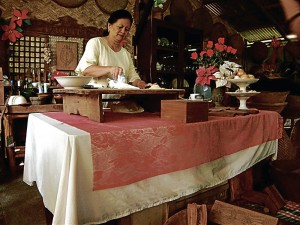
Atching Lillian Borromeo is known to the culinary world as the expert on traditional Kapampangan cuisine. To her I owe much, for she is the woman who so unselfishly allows me the privilege of reliving the glory of the past through her stories and cooking techniques and the uniqueness of her cuisine.
During our recent conversation, I gathered that Atching Lillian’s grandmother, the late Maura Hizon Lorenzo, was instrumental in making her most joyful and vivid memories of Christmas.
Aside from making everyone in her family wear nothing but new clothes for Midnight Mass and partake of the noche buena spread wearing them, regardless of how uncomfortable her whole brood must have been, Maura was the captain of the kitchen who saw to it that everyone was doing their fair share to ensure that every detail and every dish for their family’s noche buena feast was prepared to perfection.
Lola Maura’s spread lives on through Atching Lillian, who prepares it just as her lola and her mother Paquita Mercado taught her. Being the cook that she is, the Borromeos’ Christmas table narrative was told to me in cookbook form:
“When our harvest was plentiful, we had roast turkey stuffed with castañas and served with potatoes, but when my mother did not earn and our harvest fell short, we settled for asadong capon. She prepared it by rubbing the bird with two tablespoons of pounded garlic, salt, freshly cracked pepper, and 1/3 cup soy sauce; then she squeezed the juice of 10 dayap. The capon was then marinated for a couple of hours, since we had no electricity then.
Huge cooking vessel
“After marinating, a huge cooking vessel was filled with lard, and the capon cooked on all sides to brown. The excess oil was removed, leaving just a little bit of it. One cup chopped tomatoes, two pieces chopped onions, two bay leaves, and freshly cracked peppers were added with the marinade and another ½ cup of soy sauce.
“We put enough water to cover the capon. We cooked this over low fire, turning it every so often to cook evenly. Once the capon was soft and the liquid reduced, mama added three to four pieces of chicken liver, and when it was cooked, she mashed it to thicken the sauce. Then it was seasoned to taste. If it lacked sourness, a little vinegar was added. Just before mama turned the heat off, she would put a pinch of panucha and a splash of Perrins.
“We also had ham, hamon de punda; the Chinese hams of old were called hamon de punda because they looked like pillowcases. To cook it was a long process. Impo (grandmother) soaked it in water the night before Christmas Eve, and in the morning brushed the ham to remove the mold. She then boiled it in a combination of liquids—a bottle of cerveza negra, one cup anisado, one liter pineapple juice, and just enough water to cover the ham. It was boiled for a long time over low heat until soft.
“Once soft, the ham was skinned and cooled on a tray. It was then sprinkled with brown sugar, and with the back of a heated metal sianse, the sugar got caramelized until it melted.
“Today, the torch makes this process much easier. For the sauce, the pineapple juice that was used to soften the ham was reduced, then sweetened with sugar. It was cooked until it was the consistency of a light syrup and served alongside the ham. I recall our ham to be so big, it was served on a big bandejado; only a little of it was sliced. As a child, I remember the ham looked as big as a lechon de leche.
To keep us together
“At this time, my mother saw to it that something made of malagkit was served, to keep us together. I recall how they used to make suman tili in a kawa, where 2.2 kilos of malagkit rice were cooked with milk from eight coconuts (ratio: one niyog + ¾ cup water extract) over low heat, stirring constantly.
“If the mixture dried out and the rice was uncooked, you could add more coconut milk. Sugar, about ½ kg, was added toward the end, once the rice had bloomed and lost its ‘eye.’
“The mixture was left to cool, then rolled to the size and width of your middle finger. The process of rolling or shaping the rice is called tili in Kapampangan, hence the suman’s name. It was then wrapped in yellow banana leaves, the ones that are very young and have not quite opened into full leaves yet.
“No noche buena was without soup—Nilagang Pasko—made by bringing a huge pot filled with water to a boil. We added onions, peppercorns and half a kilo of beef cut into chunks. We cooked the beef until it was tender, then added half a kilo of pork meat, also cut into chunks.
“Once the meat was soft, we added a couple of whole chickens and chorizo de Bilbao. We finished the soup by adding garbanzos, pechay, repolyo, Baguio pechay, or whatever greens were growing in our garden. Finally, the nilaga was seasoned with salt, and again a pinch of panucha. Panucha then was like vetsin to them; it was a flavor enhancer.
“Another Christmas dish was the Apahap, steamed, slathered with homemade mayonnaise, then sprinkled with grated queso de bola. Mom baked it in her portable oven until the queso turned brown and melted. She then garnished it with canned asparagus and tomatoes.”
Next week: Tita Lillian’s Sina-unang Ensaimada recipe. For now, we wish you all a very merry Christmas!